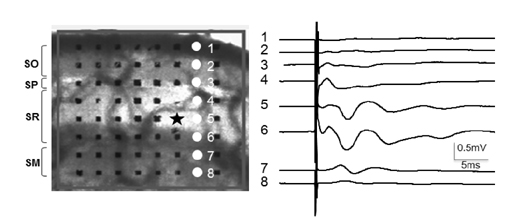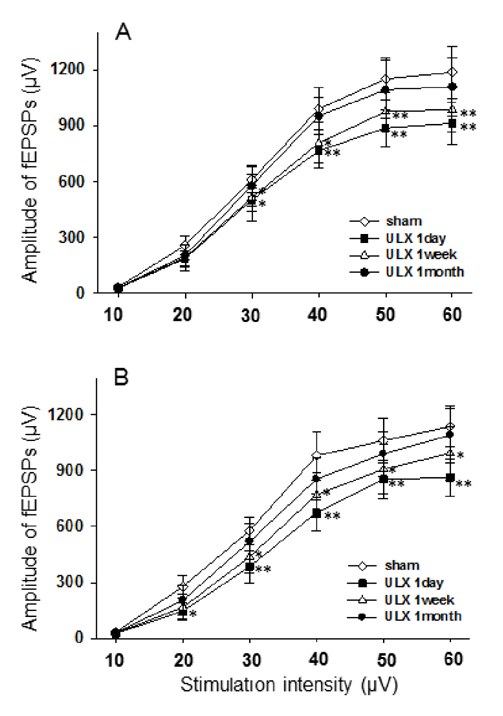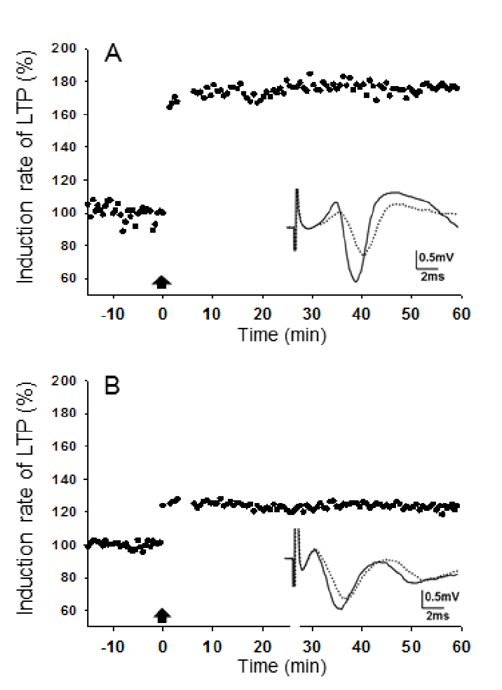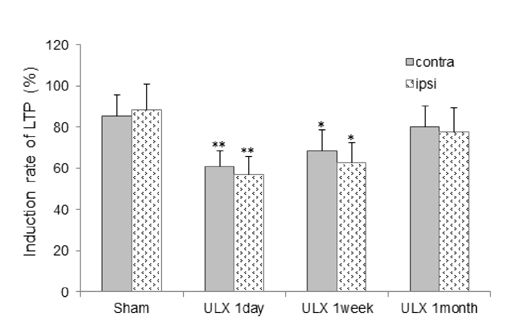Korean J Physiol Pharmacol.
2017 Jul;21(4):423-428. 10.4196/kjpp.2017.21.4.423.
Reduction of long-term potentiation at Schaffer collateral-CA1 synapses in the rat hippocampus at the acute stage of vestibular compensation
- Affiliations
-
- 1Department of Nursing, Wonkwang Health Science University, Iksan 54538, Korea.
- 2Department of Meridian & Acupoint, College of Korean Medicine, Wonkwang University, Iksan 54538, Korea.
- 3Department of Physiology, School of Medicine, Wonkwang University, Iksan 54538, Korea. mskim@wku.ac.kr
- KMID: 2384456
- DOI: http://doi.org/10.4196/kjpp.2017.21.4.423
Abstract
- Vestibular compensation is a recovery process from vestibular symptoms over time after unilateral loss of peripheral vestibular end organs. The aim of the present study was to observe time-dependent changes in long-term potentiation (LTP) at Schaffer collateral-CA1 synapses in the CA1 area of the hippocampus during vestibular compensation. The input-output (I/O) relationships of fEPSP amplitudes and LTP induced by theta burst stimulation to Schaffer's collateral commissural fibers were evaluated from the CA1 area of hippocampal slices at 1 day, 1 week, and 1 month after unilateral labyrinthectomy (UL). The I/O relationships of fEPSPs in the CA1 area was significantly reduced within 1 week post-op and then showed a non-significant reduction at 1 month after UL. Compared with sham-operated animals, there was a significant reduction of LTP induction in the hippocampus at 1 day and 1 week after UL. However, LTP induction levels in the CA1 area of the hippocampus also returned to those of sham-operated animals 1 month following UL. These data suggest that unilateral injury of the peripheral vestibular end organs results in a transient deficit in synaptic plasticity in the CA1 hippocampal area at acute stages of vestibular compensation.
MeSH Terms
Figure
Reference
-
1. Hüfner K, Strupp M, Smith P, Brandt T, Jahn K. Spatial separation of visual and vestibular processing in the human hippocampal formation. Ann N Y Acad Sci. 2011; 1233:177–186.2. Besnard S, Machado ML, Vignaux G, Boulouard M, Coquerel A, Bouet V, Freret T, Denise P, Lelong-Boulouard V. Influence of vestibular input on spatial and nonspatial memory and on hippocampal NMDA receptors. Hippocampus. 2012; 22:814–826.3. Smith PF. Vestibular-hippocampal interactions. Hippocampus. 1997; 7:465–471.4. Darlington CL, Smith PF. Molecular mechanisms of recovery from vestibular damage in mammals: recent advances. Prog Neurobiol. 2000; 62:313–325.5. Smith PF, Curthoys IS. Mechanisms of recovery following unilateral labyrinthectomy: a review. Brain Res Brain Res Rev. 1989; 14:155–180.6. Mizumori SJ, Ragozzino KE, Cooper BG, Leutgeb S. Hippocampal representational organization and spatial context. Hippocampus. 1999; 9:444–451.7. Hölscher C. Long-term potentiation: a good model for learning and memory? Prog Neuropsychopharmacol Biol Psychiatry. 1997; 21:47–68.8. Okada T, Yamada N, Tsuzuki K, Horikawa HP, Tanaka K, Ozawa S. Long-term potentiation in the hippocampal CA1 area and dentate gyrus plays different roles in spatial learning. Eur J Neurosci. 2003; 17:341–349.9. Qi X, Zhang K, Xu T, Yamaki VN, Wei Z, Huang M, Rose GM, Cai X. Sex differences in long-term potentiation at temporoammonic-ca1 synapses: potential implications for memory consolidation. PLoS One. 2016; 11:e0165891.10. Hitier M, Besnard S, Smith PF. Vestibular pathways involved in cognition. Front Integr Neurosci. 2014; 8:59.11. Smith PF, Horii A, Russell N, Bilkey DK, Zheng Y, Liu P, Kerr DS, Darlington CL. The effects of vestibular lesions on hippocampal function in rats. Prog Neurobiol. 2005; 75:391–405.12. Vitte E, Derosier C, Caritu Y, Berthoz A, Hasboun D, Soulié D. Activation of the hippocampal formation by vestibular stimulation: a functional magnetic resonance imaging study. Exp Brain Res. 1996; 112:523–526.13. Russell NA, Horii A, Smith PF, Darlington CL, Bilkey DK. Long-term effects of permanent vestibular lesions on hippocampal spatial firing. J Neurosci. 2003; 23:6490–6498.14. Brandt T, Schautzer F, Hamilton DA, Brüning R, Markowitsch HJ, Kalla R, Darlington C, Smith P, Strupp M. Vestibular loss causes hippocampal atrophy and impaired spatial memory in humans. Brain. 2005; 128:2732–2741.15. Zheng Y, Mason-Parker SE, Logan B, Darlington CL, Smith PF, Abraham WC. Hippocampal synaptic transmission and LTP in vivo are intact following bilateral vestibular deafferentation in the rat. Hippocampus. 2010; 20:461–468.16. Tai SK, Leung LS. Vestibular stimulation enhances hippocampal long-term potentiation via activation of cholinergic septohippocampal cells. Behav Brain Res. 2012; 232:174–182.17. Kim MS, Jin BK, Chun SW, Lee MY, Lee SH, Kim JH, Park BR. Role of vestibulocerebellar N-methyl-D-aspartate receptors for behavioral recovery following unilateral labyrinthectomy in rats. Neurosci Lett. 1997; 222:171–174.18. Zheng Y, Kerr DS, Darlington CL, Smith PF. Unilateral inner ear damage results in lasting changes in hippocampal CA1 field potentials in vitro. Hippocampus. 2003; 13:873–878.19. Stackman RW, Clark AS, Taube JS. Hippocampal spatial representations require vestibular input. Hippocampus. 2002; 12:291–303.20. Russell NA, Horii A, Smith PF, Darlington CL, Bilkey DK. Lesions of the vestibular system disrupt hippocampal theta rhythm in the rat. J Neurophysiol. 2006; 96:4–14.21. Horii A, Russell NA, Smith PF, Darlington CL, Bilkey DK. Vestibular influences on CA1 neurons in the rat hippocampus: an electrophysiological study in vivo. Exp Brain Res. 2004; 155:245–250.22. Diamond DM, Rose GM. Stress impairs LTP and hippocampal-dependent memory. Ann N Y Acad Sci. 1994; 746:411–414.23. Diamond DM, Park CR, Campbell AM, Woodson JC. Competitive interactions between endogenous LTD and LTP in the hippocampus underlie the storage of emotional memories and stress-induced amnesia. Hippocampus. 2005; 15:1006–1025.24. Pavlowsky A, Wallace E, Fenton AA, Alarcon JM. Persistent modifications of hippocampal synaptic function during remote spatial memory. Neurobiol Learn Mem. 2017; 138:182–197.25. Lacour M, Helmchen C, Vidal PP. Vestibular compensation: the neuro-otologist's best friend. J Neurol. 2016; 263:Suppl 1. S54–S64.26. Hüfner K, Strupp M, Smith P, Brandt T, Jahn K. Spatial separation of visual and vestibular processing in the human hippocampal formation. Ann N Y Acad Sci. 2011; 1233:177–186.27. Péruch P, Borel L, Gaunet F, Thinus-Blanc G, Magnan J, Lacour M. Spatial performance of unilateral vestibular defective patients in nonvisual versus visual navigation. J Vestib Res. 1999; 9:37–47.28. Péruch P, Borel L, Magnan J, Lacour M. Direction and distance deficits in path integration after unilateral vestibular loss depend on task complexity. Brain Res Cogn Brain Res. 2005; 25:862–872.29. Zheng Y, Darlington CL, Smith PF. Impairment and recovery on a food foraging task following unilateral vestibular deafferentation in rats. Hippocampus. 2006; 16:368–378.30. Zheng Y, Smith PF, Darlington CL. Subregional analysis of amino acid levels in the guinea pig hippocampus following unilateral vestibular deafferentation. J Vestib Res. 1999; 9:335–345.31. Liu P, Zheng Y, King J, Darlington CL, Smith PF. Long-term changes in hippocampal n-methyl-D-aspartate receptor subunits following unilateral vestibular damage in rat. Neuroscience. 2003; 117:965–970.32. Markia B, Kovács ZI, Palkovits M. Projections from the vestibular nuclei to the hypothalamic paraventricular nucleus: morphological evidence for the existence of a vestibular stress pathway in the rat brain. Brain Struct Funct. 2008; 213:239–245.33. Saman Y, Bamiou DE, Gleeson M, Dutia MB. Interactions between stress and vestibular compensation: a review. Front Neurol. 2012; 3:116.34. Cameron SA, Dutia MB. Lesion-induced plasticity in rat vestibular nucleus neurones dependent on glucocorticoid receptor activation. J Physiol. 1999; 518:151–158.35. Gustave Dit Duflo S, Gestreau C, Tighilet B, Lacour M. Fos expression in the cat brainstem after unilateral vestibular neurectomy. Brain Res. 1999; 824:1–17.36. Lindsay L, Liu P, Gliddon C, Zheng Y, Smith PF, Darlington CL. Cytosolic glucocorticoid receptor expression in the rat vestibular nucleus and hippocampus following unilateral vestibular deafferentation. Exp Brain Res. 2005; 162:309–314.37. Shors TJ, Gallegos RA, Breindl A. Transient and persistent consequences of acute stress on long-term potentiation (LTP), synaptic efficacy, theta rhythms and bursts in area CA1 of the hippocampus. Synapse. 1997; 26:209–217.38. Dong Z, Gong B, Li H, Bai Y, Wu X, Huang Y, He W, Li T, Wang YT. Mechanisms of hippocampal long-term depression are required for memory enhancement by novelty exploration. J Neurosci. 2012; 32:11980–11990.39. Ge Y, Dong Z, Bagot RC, Howland JG, Phillips AG, Wong TP, Wang YT. Hippocampal long-term depression is required for the consolidation of spatial memory. Proc Natl Acad Sci U S A. 2010; 107:16697–16702.
- Full Text Links
- Actions
-
Cited
- CITED
-
- Close
- Share
- Similar articles
-
- Dopamine Receptor Supports the Potentiation of Intrinsic Excitability and Synaptic LTD in Temporoammonic-CA1 Synapse
- Changes in Synaptic Transmission and Long-term Potentiation Induction as a Possible Mechanism for Learning Disability in an Animal Model of Multiple Sclerosis
- Effects of N-acetylcystein on changes in parvalbumin-positive interneurons in the hippocampus after carbon monoxide poisoning
- Long-term Synaptic Plasticity: Circuit Perturbation and Stabilization
- Effects of Saccharin Intake on Hippocampal and Cortical Plasticity in Juvenile and Adolescent Rats





